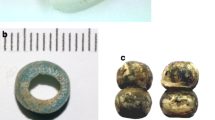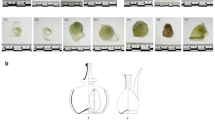Abstract
The accurate determination of archaeological glass sample composition is challenging due to possible heterogeneity and post-production chemical alteration. Here, depth profiling using the time resolved signal generated by LA-ICP-MS (DP-LA-ICP-MS) is applied to two case studies. The first study concerns corroded Late Bronze Age glass beads. While many varieties of ancient glass beads are corrosion resistant, some recipes are particularly impacted by devitrification, and depth profiling allows for analysis of un-corroded material reflecting original glass composition. In the second case study on a seventeenth century composite glass vessel, depth profiling allowed for measurement of composite layers including a thin ruby gold glass layer and white opaque glass filigree embedded in colorless lead glass. The minimal destructiveness of this technique combined with other advantages of LA-ICP-MS—the large number of elements that can be measured and low detection limits—make this technique ideal for analysis of many kinds of compositionally complex glass objects.
Access this chapter
Tax calculation will be finalised at checkout
Purchases are for personal use only
Similar content being viewed by others
References
Angelini I, Artioli G, Bellintani P, Diella V, Gemmi M, Polla A, Rossi A (2004) Chemical analyses of Bronze Age glasses from Frattesina di Rovigo, Northern Italy. J Archaeol Sci 31(8):1175–1184
Azemar R, Billaud Y, Costantini G, Gratuze B (2000) Les perles protohistoriques de l’Aveyron. Cahiers d’Archéologie Aveyronnaise 14:75–88
Barca D, Abate M, Mirocle Crisci G, De Presbiteris D (2009) Post-medieval glass from the Castle of Cosenza, Italy: chemical characterization by LA-ICP-MS and SEM-EDS. Per Mineral 78(2):49–64
Bellintani P, Stefan L (2009) Nuovi dati sul primo vetro europeo: il caso di Frattesina. In: Atti del Primo Convegno Interdisciplinare sul Vetro nei Beni Culturali e nell’Arte di Ieri e di Oggi, Parma 27–28 novembre 2008. Aula Magna, Università degli Studi di Parma, Parma, pp 71–86
Bellintani P, Biavati A, Verità M (1998) Alcune considerazioni su materiali vetrosi da constesti dell’età del Bronzo media e recente dell’Italia settentrionale. In: La Guardia R (ed) Il vetro dall’antichità all’età contemporanea: aspetti tecnologici, funzionali e commerciali, Atti 2e Giornate Nazionali di Studio AIHV-Camitato Nazionale Italiano (Milano, 14–15 dicembre 1996). Edizioni Et, Milano, pp 15–24
Biavati A, Verità M (1989) The glass from Frattesina, a glassmaking center in the late Bronze Age. Rivista della Staz Sper Vetro 4:295–299
Biron I, Gratuze B, Pistre S (2010) Etude en laboratoire d’objets en verre attribués à Bernard Perrot. In: Gorget C, Klinka I (eds) Bernard Perrot, Secret et chefs-d’œuvre des verreries royales d’Orléans. Musée des Beaux-Arts d’Orléans and Somogy, Orléans and Paris, pp 87–93
Biron I, Gratuze B, Lehuede P, Pistre S (2011) Etude en laboratoire d’objets en verre attribués à Bernard Perrot. Bulletin de l’AFAV 2011:19–25
Brill RH (1992) Chemical analysis of some glasses from Frattesina. J Glass Stud 34:11–22
Brill RH (1999) Chemical analyses of early glasses. Corning Museum of Glass, New York
Bronk H, Freestone IC (2001) A quasi non-destructive microsampling technique for the analysis of intact glass objects by SEM-EDXA. Archaeometry 43(4):517–527
Carmona N, Ortega-Feliu I, Gómez-Tubío B, Villegas MA (2010) Advantages and disadvantages of PIXE/PIGE, XRF and EDX spectrometries applied to archaeometric characterisation of glasses. Mater Charact 61:257–267
Cosyns P, Warmenbol E, Bourgeois J, Degryse P (2005) Pre-Roman glass beads in Belgium. In: Nenna MD (ed) Annales du 16e Congrès de l’Association Internationale pour l’Histoire du Verre, London 2003. AIHV, Nottingham, pp 323–326
Dussubieux L, Robertshaw P, Glascock MD (2009) LA-ICP-MS analysis of African beads: laboratory inter-comparison with an emphasis on the impact of corrosion on data interpretation. Int J Mass Spectrom 284(1-3):152–161
Fricker M-B, Kutscher D, Aeschlimann B, Frommer J, Dietiker R, Bettmer J, Günther D (2011) High spatial resolution trace element analysis by LA-ICP-MS using a novel ablation cell for multiple or large samples. Int J Mass Spectrom 307(1–3):39–45
Geyssant J (2010) Secret du verre rouge transparent de Bernard Perrot et comparaison avec celui de Jehann Kunckel. In: Gorget C, Klinka I (eds) Bernard Perrot, Secret et chefs-d’œuvre des verreries royales d’Orléans. Musée des Beaux-Arts d’Orléans and Somogy, Orléans and Paris, pp 51–54
Geyssant J, Gorget C, Tétart-Vittu F (2010) Présentation, particularités et catalogue des œuvres exposées. In: Gorget C, Klinka I (eds) Bernard Perrot, Secret et chefs-d’œuvre des verreries royales d’Orléans. Musée des Beaux-Arts d’Orléans and Somogy, Orléans and Paris, pp 95–184
Giussani B, Monticelli D, Rampazzi L (2009) Role of laser ablation–inductively coupled plasma–mass spectrometry in cultural heritage research: A review. Anal Chim Acta 635:6–21
Glaus R, Koch J, Günther D (2012) Portable laser ablation sampling device for elemental fingerprinting of objects outside the laboratory with laser ablation inductively coupled plasma mass spectrometry. Anal Chem 84(12):5358–5364
Gratuze B (1999) Obsidian characterisation by laser ablation ICP-MS and its application to prehistoric trade in the Mediterranean and the Near East: sources and distribution of obsidian within the Aegean and Anatolia. J Archaeol Sci 26(8):869–881
Gratuze B, Billaud Y (2003) La circulation des perles en verre dans le Bassin méditerranéen de l’Age du Bronze moyen jusqu’au Hallstatt. In: Foy D, Nenna MD (eds) Echanges et commerce du verre dans le monde antique, actes du colloque de l’AFAV, Aix-en-Provence Marseille 7–9 juin 2001. Monique Mergoil, Montagnac, pp 11–15
Gratuze B, Louboutin C, Billaud Y (1998) Les perles protohistoriques en verre du musée des Antiquités nationales. Antiquités nationales 30:13–24
Guilaine J, Gratuze B, Barrandon JN (1991) Les perles de verre du chalcolithique et de l’Age du Bronze. Analyses d’exemplaires trouvés en France. In: Chevillot C, Coffyn A (eds) L’Age du Bronze Atlantique, Actes du 1er colloque du parc archéologique de Beynac. Edition de l’association des musées du Sarladais, Beynac et Cazenac, pp 255–266
Hartmann G, Kappel I, Grote K, Arndt B (1997) Chemistry and technology of prehistoric glass from Lower Saxony and Hesse. J Archaeol Sci 24(6):547–559
Heinrich CA, Pettke T, Halter WE, Aigner-Torres M, Audetat A, Gunther D, Hattendorf B, Bleiner D, Guillong M, Horn I (2003) Quantitative multi-element analysis of minerals, fluid and melt inclusions by laser-ablation inductively-coupled-plasma mass-spectrometry. Geochim Cosmochim Ac 67(18):3473–3497
Henderson J (1988) Electron probe microanalysis of mixed-alkali glasses. Archaeometry 30(1):77–91
Henderson J (1989) The earliest glass in Britain and Ireland. In: Feugère M (ed) Le verre préromain en Europe occidentale. Monique Mergoil, Montagnac, pp 13–24
Henderson J (1993) Chemical analysis of the glass and faience from Hauterive-Champréveyres, Switzerland. In: Rychner-Faraggi AM (ed) Hauterive-Champréveyres 9, Métal et Parure au Bronze Final. Musée Cantonal d’Archéologie Archéologie neuchâteloise, Neuchâtel, pp 111–117
Hollocher K, Ruiz J (1995) Major and trace element determination on NIST glass standard reference material 611, 612, 614 and 1834 by inductively coupled plasma mass spectrometry. Geostandard Newslett 19(1):27–34
Jochum KP, Weis U, Stoll B, Kuzmin D, Yang Q, Raczek I, Jacob D-E, Stracke A, Birbaum K, Frick D-A, Günther D, Enzweiler J (2011) Determination of reference values for NIST SRM 610-617 glasses following ISO Guidelines. Geostandard Geoanal Res 34(4):397–429
Kovacs R, Nishiguchi K, Utani K, Günther D (2010) Development of direct atmospheric sampling for laser ablation-inductively coupled plasma-mass spectrometry. J Anal Atom Spectrom 25:142–147
Mason PRD, Mank AJG (2001) Depth-resolved analysis in multi-layered glass and metal materials using laser ablation inductively coupled plasma mass spectrometry (LA-ICP-MS). J Anal Atom Spectrom 16:1381–1388
Nenna MD, Gratuze B (2009) Étude diachronique des compositions de verres employés dans les vases mosaïqués antiques: résultats préliminaires. In: Janssens K, Degryse P, Cosyns P, Caen J, Van’t dack L (eds) Annales of the 17th Congress of the International Association for the History of Glass, 2006, Antwerp. VUP University Press, Brussels, pp 199–205
Nikita K, Henderson J, Nightingale G (2009) An archaeological and scientific study of Mycenaean glass from Elateia-Alonaki, Greece. In: Janssens K, Degryse P, Cosyns P, Caen J, Van’t dack L (eds) Annales of the 17th Congress of the International Association for the History of Glass, 2006, Antwerp. VUP University Press, Brussels, pp 39-46
Norman MD, Pearson NJ, Sharma A, Griffin WL (1996) Quantitative analysis of trace elements in geological materials by laser ablation ICPMS: instrumental operating conditions and calibration values of NIST glasses. Geostandard Newslett 20(2):247–262
Pearce NJG, Perkins WT, Westgate JA, Gorton MP, Jackson SE, Neal CR, Chenery SP (1997) A compilation of new and published major and trace element data for NIST SRM 610 and NIST SRM 612 glass reference materials. Geostandard Newslett 21(1):115–144
Ploin S, Koenig M-P, Gratuze B (2012) Les perles en verre de l’âge du Bronze et du premier âge du Fer d’Alsace et de Lorraine. In: Arveiller V, Cabart H (eds) Le verre en Lorraine et dans les régions voisines, Actes des 26ème rencontres de l’AFAV, Metz 2011, Monographie Instrumentum 42. Monique Mergoil, Montagnac, pp 11–36
Raftery B, Henderson J (1987) Some glass beads of the Later Bronze Age in Ireland. In: Frey O-H, Haevernick TE, Matthäus H, Braun C (eds) Glasperlen der vorrömischen Eisenzeit I. von Zabern, Mainz, pp 39–53
Robertshaw P, Wood M, Haour A, Karklins K, Neff H (2014) Chemical analysis, chronology, and context of a European glass bead assemblage from Garumele, Niger. J Archaeol Sci 41:591–604
Van der Werf I, Mangone A, Giannossa L-C, Traini A, Laviano R, Coralini A, Sabbatini L (2009) Archaeometric investigation of Roman tesserae from Herculaneum (Italy) by the combined use of complementary micro-destructive analytical techniques. J Archaeol Sci 36(12):2625–2634
Varberg J, Gratuze B, Kaul F (2015) Between Egypt, Mesopotamia and Scandinavia: Late Bronze Age glass beads found in Denmark. J Archaeol Sci 54:168–181
Venclová N, Hulínský V, Henderson J, Chenery S, Šulová L, Hložek J (2011) Late Bronze Age mixed-alkali glasses from Bohemia, Skla typu mixed alkali mladší doby bronzové v Čechách. Archeologické rozhledy LXIII–2011:559–585
Verità M, Basso R, Wypyski MT, Koestler RJ (1994) X-ray microanalysis of ancient glassy materials: a comparative study of wavelength dispersive and energy dispersive techniques. Archaeometry (36)2:241–251
Vicenzi EP, Eggins S, Logan A, Wysoczanski R (2002) Microbeam characterization of Corning archeological reference glasses: new additions to the Smithsonian microbeam standard collection. J Res Natl Inst Stand 107(6):719–727
von Kerssenbrock-Kosigk D (2008) Glass of the alchemists: lead crystal–gold ruby, 1650–1750. Corning Museum of Glass, New York
Wagner B, Nowak A, Bulska E, Hametner K, Günther D (2012) Critical assessment of the elemental composition of Corning archeological reference glasses by LA-ICP-MS. Anal Bioanal Chem 402:1667–1677
Walder H (2013) Stylistic and chemical investigation of turquoise blue glass artifacts from the Contact Era of Wisconsin. Midcontinent J Archaeol 38(1):119–142
Walton MS, Shortland A, Kirk S, Degryse P (2009) Evidence for the trade of Mesopotamian and Egyptian glass to Mycenaean Greece. J Archaeol Sci 36(7):1496–1503
Wedepohl K-H, Simon K, Kronz A (2011) Data on 61 chemical elements for the characterization of three major glass compositions in Late Antiquity and the Middle Ages. Archaeometry 53(1):81–102
Woodhead J, Hellstrom J, Paton C, Hergt J, Greig A, Maas R (2008) A guide to depth profiling and imaging applications of LA-ICP-MS. In: Sylvester P (ed) Laser ablation ICP–MS in the earth sciences: current practices and outstanding issues. Mineralogical Association of Canada, Vancouver, BC, pp 135–145
Author information
Authors and Affiliations
Corresponding author
Editor information
Editors and Affiliations
Rights and permissions
Copyright information
© 2016 Springer-Verlag Berlin Heidelberg
About this chapter
Cite this chapter
Gratuze, B. (2016). Glass Characterization Using Laser Ablation-Inductively Coupled Plasma-Mass Spectrometry Methods. In: Dussubieux, L., Golitko, M., Gratuze, B. (eds) Recent Advances in Laser Ablation ICP-MS for Archaeology. Natural Science in Archaeology. Springer, Berlin, Heidelberg. https://doi.org/10.1007/978-3-662-49894-1_12
Download citation
DOI: https://doi.org/10.1007/978-3-662-49894-1_12
Published:
Publisher Name: Springer, Berlin, Heidelberg
Print ISBN: 978-3-662-49892-7
Online ISBN: 978-3-662-49894-1
eBook Packages: Social SciencesSocial Sciences (R0)




